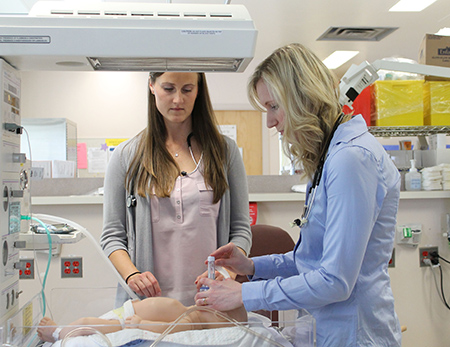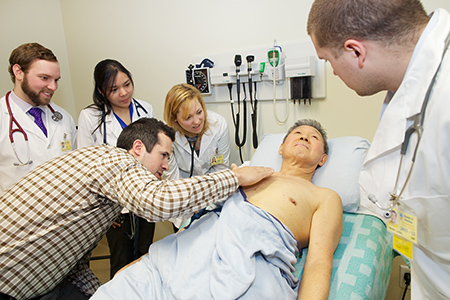Southern Medical Program transforms health care in B.C.’s Interior

Clinical Assistant Professor Melissa Paquette teaches medical student Kristin Morch in the pediatric unit at Royal Inland Hospital. Photo credit: Warren Brock
A decade ago, the doctors of B.C.’s Interior gave little thought to teaching, mostly because they didn’t have to: Other than a rural family medicine residency in Kelowna, and a smattering of electives in that city and in a few other towns, medical students and residents seldom made an appearance.
All that began to change in 2005, when the provincial government announced that UBC’s medical education program – which by then had already spread to northern B.C. and Vancouver Island – would also plant stakes in the Interior.
Within the Okanagan alone, over 100 family physicians were needed to teach in the first two years of the Southern Medical Program (SMP). Another 200 specialists would be necessary to deliver clinical teaching at Kelowna General Hospital. And as the SMP moved toward its full capacity of 128 students, it would need even more.
The territory ahead was both uncharted and even daunting. But now, with the Southern Medical Program having graduated its first students in May, the contours have emerged, with about 200 medical students and residents becoming a common feature of the health care landscape, spread over 216,000 square kilometres.
“We decided early on that we were going to be a program of the Interior, in its entirety,” says Allan Jones, the Regional Associate Dean, Interior. “Kelowna was going to be key, but more hospitals and teaching capacity were essential for us to carry the day.”
Contagious enthusiasm
The Southern Medical Program looked to the Interior’s regional hospitals to help fill its training needs. Two hours to the north, in Kamloops, Royal Inland Hospital was seen as an untapped resource of capable teachers. Similar environments existed at Vernon Jubilee and Kootenay Boundary Regional Hospitals.

Cheryl Holmes teaches medical students and residents about critical care in Kelowna General Hospital’s intensive care unit. Photo credit: Warren Brock
Formal rotations were piloted, evaluated, refined, and tailored to best fit the model of care.
“We listened to physicians and tried to create individualized educational models that would fit each department,” says Cheryl Holmes, a Clinical Associate Professor in the Department of Medicine and the Site Leader for medical education at Kelowna General Hospital. “The enthusiasm was contagious, and gradually more and more physicians were brought into the fold.”
In contrast to medical education programs in large urban centres, the teaching environment that emerged in the Interior was flatter, unencumbered by the hierarchical layers of major teaching hospitals. Students spent most of their time working one-on-one with attending physicians and had more face-time with patients.
That informality and familiarity also meant that students gained more exposure to the offerings of the Interior. Preceptors took students out to dinner, to Kamloops Blazers hockey games, or skiing at Sun Peaks, says Gerhard Schumacher, a Clinical Assistant Professor in the Department of Family Practice who was the Site Co-Leader for medical education in Kamloops, until leaving this spring for Kenya.
Such gestures were not obligatory attempts at hospitality, Dr. Schumacher says. He and his colleagues discovered – in some cases, to their surprise – that they were taken in by the students’ insatiable thirst for knowledge, their enthusiasm, and their eagerness to dive into new experiences.
“Many of the faculty discovered a love of teaching, and saw it as an opportunity to give back,” he says. “The students push them to stay current with the latest developments within their medical field.”
Starting slow, then moving forward
The experience of Tanja Redelinghuys, a Vernon family physician, was typical. She tentatively agreed to be a preceptor with the rural family practice program in 2009. Her reservations were understandable: She hadn’t taught in Canada, and having been educated and trained in South Africa, she wasn’t completely familiar with Canada’s medical training model.

Clinical Assistant Professor Josh Williams leads a clinical skills session at Kelowna General Hospital. Photo credit: Darren Hull
“My biggest concern was knowing enough to teach the students,” she says. “I learned to start slow, assess the students to see what they know, and go from there.”
When the Southern Medical Program launched three years later, it brought first- and second-year medical students to her clinic on a weekly basis. Their constant presence brought some challenges – for example, persuading female patients to undergo sensitive exams with a male student present. But through coaching and greater familiarity, Dr. Redelinghuys saw her patients become more accommodating.
“My patients know that I teach students, and the patients like it,” she says. “As they hear me discuss their cases with the students, they get to learn more about themselves and their medical conditions.”
The number of Interior physicians teaching students and residents now surpasses 800, spanning 30 different communities. That network has enabled the expansion of postgraduate training in the Interior, with new family medicine residencies in Kamloops and Kootenay Boundary, and an emergency medicine residency in Kelowna.
Dr. Jones, the Regional Associate Dean, hopes that the pioneering students of the Southern Medical Program and the Interior’s residency programs have such positive experiences that they return to (or remain in) the region – not only to work as physicians, but to teach students and residents who come after them.
“We are creating a self-sustaining culture of academic medicine, where one hadn’t existed before,” he says. “Creating a culture takes time, but I’m amazed by how much transformation has taken place already.”